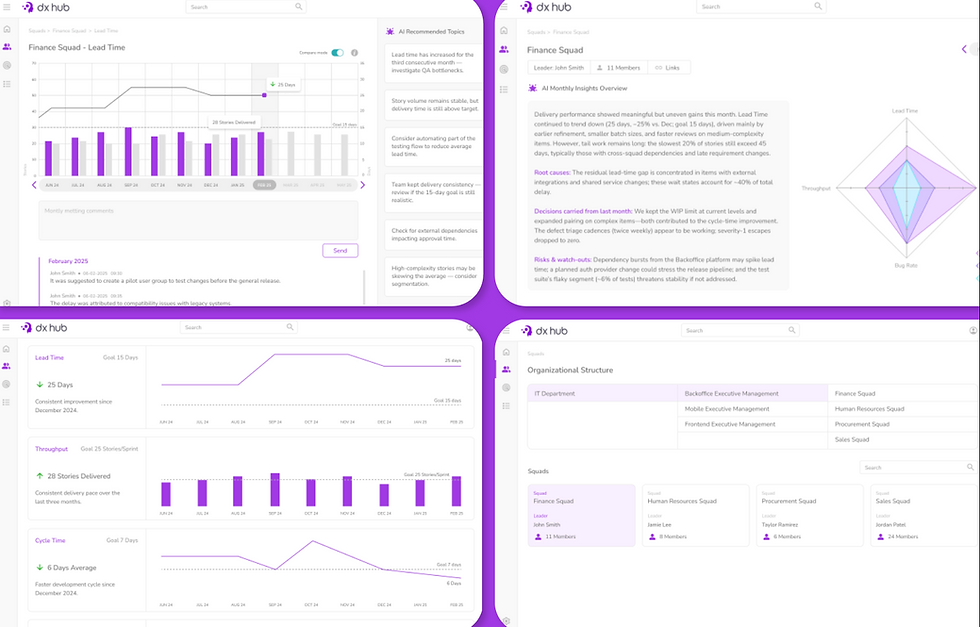8 Causes of Slower Software Delivery and How Investors Can Help
- Avalia

- May 13, 2022
- 4 min read
Updated: Jun 19, 2023
What are the root causes of delivery delays and how can investors support and drive growth?
We showed how a two-week delay held up one squad of ten people in an R&D organisation with a staff of 100 developers, which snowballed into the destruction of one third of the enterprise value and reduced the company’s growth rate from the planned 30% to 18% year-on-year.
What could cause a two-week delay in software delivery?
Software development is inherently risky due to the wide range of potential problems that could arise from the technology, processes, and people domains.
Here are some examples of what might contribute to delays in software delivery:
Developer Churn
The company may have high developer churn, implying that a large amount of time will be spent onboarding new developers, which would impact productivity and potentially lead to a loss of key knowledge depending on the quality of the documentation and knowledge-sharing practices. The company might also suffer the loss of a key contributor to the codebase - someone with exclusive knowledge of the code's architecture, for example - and without adequate knowledge-sharing practices, the remaining team would need to spend time recovering that knowledge.
For a team, a high churn rate often induces a loss of knowledge regarding the code base, excessive time spent onboarding new members, as well as a deterioration of collaborative practices and synergies between developers. All of these factors can have varying negative influences on the speed of software delivery, in turn affecting the business relying on it. Developer churn rate is one of the metrics leveraged by Avalia’s automated tooling platform when conducting data-driven Software Due Diligence. - Guillaume Serneels, Avalia Software and Data Engineer
Lack of Automated Testing
If the automated testing approach has low coverage and the quality assurance strategy relies excessively on manual testing, it results in the creation of bugs when changes are made, which in turn can impact the quality and speed of delivery.
Poor Documentation
When things are poorly documented, it has a huge impact on productivity. In the context of developer onboarding, it would be very difficult to acquire knowledge quickly and know what to do or how to fix things without adequate documentation.
Lack of Domain Knowledge
Frequently moving developers from one area of work to another, for example, may stunt domain knowledge development and impact productivity and efficiency.
Context Switching and Priority Changes
Frequent context changes and reprioritisation have an impact on speed of delivery. A developer may need time to figure out complex code, but during that time other priorities will invariably come up. Switching tasks breaks the developer’s flow, which has a productivity cost.
The processes to manage product plans and development can also be a big source of delivery speed loss. Specifically, the application of the processes by the team, their complexity in relation to the size of the company or project, or a lack of processes or indicators can all instigate delivery speed losses. Avalia has several development indicators for processes that can help increase a team’s performance and delivery speed. - Maurício Bento, Avalia Systems Business Director.
Unclear Specifications
The way people collaborate and the quality of specifications can lead to misunderstandings of what is required and create costly rework and delays in deliveries.
Accumulation of Technical Debt
An imbalance in time spent on new features versus architectural or engineering results in unmanaged complexity which cripples business through erratic application behaviour, quickly growing provision costs and making the team's productivity unpredictable.
Software delivery speed is important, because it feeds into a virtuous cycle. Teams who are 'in the zone' have found a way to improve their software at a steady pace. They have found a good balance between the time spent on new features and the time spent on taking care of the software structure. In these teams, satisfaction and motivation are high, which translate into sustainable quality work. - Olivier Liechti, Avalia Co-Founder and CTO
Any combination of these and other risks can feed a vicious cycle that impacts software delivery speed. The root causes of delivery delays may stem from unexpected issues, communication challenges, and unidentified risks.
A data-driven assessment of the technology, processes, and people dynamics is the route to gaining insight into the potential problem areas and a course of action for improvement and risk mitigation.
The slower the delivery speed the longer it takes for the planned growth to be reached. And for investors, this delay means lower returns by the time they exit the investment.
Software Due Diligence: A Critical Step in Tech Investment
Maximising returns in investments where technology innovation is the driving force for growth depends on assessing the business plan, identifying critical risks, and planning for improvements early on. There is no better time to do this than in the Software Due Diligence.
Avalia System's data-driven Software Due Diligence connects the dots between technology and business to provide answers to key questions:
Can the business plan be delivered in the current scenario?
What metrics are needed for effective tech governance?
What needs to be prioritised in the 100-day plan?
With the complete picture, key insights, and an action plan, investors are empowered to help their portfolio companies meet their objectives and achieve better results quickly.
Find out more about Avalia’s business-centric Software Due Diligence: book a call.


